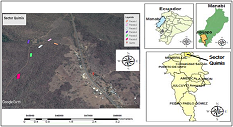Structure and tree composition on the tropical dry forest in Sancán valley, Manabí, Ecuador
Main Article Content
Abstract
Downloads
Article Details

This work is licensed under a Creative Commons Attribution-NonCommercial 4.0 International License.
References
AGUIRRE, L., ANDERSON, E. y BREHM, G., 2013. Fenología y relaciones ecológicas interespecíficas de la Biota Andina frente al cambio climático. En: S. HERZOG, P. JØRGENSEN, R. MARTINEZ y H. TIESSEN, Cambio climático y biodiversidad en los Andes Tropicales [en línea]. Francia: Springer, Disponible en: https://www.researchgate.net/publication/245023891_Cambio_Climatico_y_Biodiversidad_en_los_Andes_Tropicales_Fenologia_y_Relaciones_Ecologicas_Interespecificas_de_la_Biota_Andina_Frente_al_Cambio_Climatico.
AGUIRRE MENDOZA, Z., AGUIRRE MENDOZA, N. y MUÑOZ, J., 2017. Biodiversidad de la provincia de Loja, Ecuador. Arnaldoa [en línea], vol. 24, no. 2, pp. 523-542. [Consulta: 9 julio 2020]. Disponible en: https://www.academia.edu/39841827/Biodiversidad_de_la_provincia_de_Loja_Ecuador_Biodiversity_of_the_province_of_Loja_Ecuador.
AGUIRRE MENDOZA, Z., APONTE CÓRDOVA, C.M. y QUIZHPE, W., 2021a. Bosque seco de la parroquia Mangahurco, Zapotillo, Loja, estudio de su composición florística, estructura y endemismo. Ciencia Latina. Revista Científica Multidisciplinar [en línea], vol. 5, no. 5, pp. 7162-7182. DOI 10.37811/cl_rcm.v5i5.838. Disponible en: https://www.researchgate.net/publication/355194865_Bosque_seco_de_la_parroquia_Mangahurco_Zapotillo_Loja_estudio_de_su_composicion_floristica_estructura_y_endemismo.
AGUIRRE MENDOZA, Z., CANGO SARANGO, L. y QUIZHPE, W., 2021b. Composición florística, estructura y endemismo del componente leñoso del bosque Huashapamba, Loja, Ecuador. Revista Cubana de Ciencias Forestales [en línea], vol. 9, no. 1, pp. 1-16. [Consulta: 12 abril 2022]. ISSN 2310-3469. Disponible en: https://cfores.upr.edu.cu/index.php/cfores/article/view/670.
AGUIRRE MENDOZA, Z., CELI DELGADO, H. y HERRERA HERRERA, C., 2018. Estructura y composición florística del bosque siempreverde montano bajo de la parroquia San Andrés, cantón Chinchipe, provincia de Zamora Chinchipe, Ecuador. Arnaldoa [en línea], vol. 25, no. 3, pp. 923-938. [Consulta: 12 abril 2022]. ISSN 2413-3299. DOI 10.22497/arnaldoa.253.25306. Disponible en: http://www.scielo.org.pe/scielo.php?script=sci_abstract&pid=S2413-32992018000300006&lng=es&nrm=iso&tlng=en.
AGUIRRE MENDOZA, Z., CHAMBA VALAREZO, M., DÍAZ LÓPEZ, M. y PACHECO PINEDA, E., 2021c. Composición florística y estructura de un remanente de bosque seco en la Estación Experimental Zapotepamba, Loja, Ecuador. Bosques Latitud Cero [en línea], vol. 11, no. 1, pp. 97-112. [Consulta: 12 abril 2022]. ISSN 2528-7818. Disponible en: https://revistas.unl.edu.ec/index.php/bosques/article/view/877.
AGUIRRE, Z., BETANCOURT, Y., GEADA, G. y JASEN, H., 2013. Composición florística, estructura de los bosques secos y su gestión para el desarrollo de la provincia de Loja, Ecuador. Avances [en línea], vol. 15, no. 2, pp. 144-155. ISSN 1562-3297. Disponible en: https://dialnet.unirioja.es/servlet/articulo?codigo=5350870.
AITKEN, Sally N., et al. Adaptation, migration or extirpation: climate change outcomes for tree populations. Evolutionary applications, 2008, vol. 1, no 1, p. 95-111. https://onlinelibrary.wiley.com/doi/pdf/10.1111/j.1752-4571.2007.00013.x
ASTUDILLO SÁNCHEZ, E., PÉREZ, J., TROCCOLI, L. y APONTE, H., 2019. Composición, estructura y diversidad vegetal de la Reserva Ecológica Comunal Loma Alta, Santa Elena, Ecuador. Revista Mexicana de Biodiversidad [en línea], vol. 90, pp. 1-25. [Consulta: 12 abril 2022]. ISSN 1870-3453. DOI 10.22201/ib.20078706e.2019.90.2871. Disponible en: http://www.scielo.org.mx/scielo.php?script=sci_abstract&pid=S1870 -34532019000100618&lng=es&nrm=iso&tlng=es.
BAUTISTA MIRANDA, R., 2019. Restauración productiva de bosques en comunidades ubicadas en zonas de recuperación, uso especial y de amortiguamiento en tres áreas protegidas de Guatemala. Revista Yu'am [en línea], vol. 3, no. 6, pp. 22-36. Disponible en: https://www.revistayuam.com/wp-content/uploads/2019/09/Restauracion-productiva.pdf.
FAO, 2018. El estado de los bosques del mundo 2018 [en línea]. Roma, Italia: FAO. [Consulta: 12 abril 2022]. Disponible en: https://www.fao.org/publications/card/fr/c/I9535ES/.
JIMÉNEZ, A., CEDEÑO, M.J., VERA, L.M. y ROSETE, S. 2021. Caracterización de las especies melíferas en el bosque seco tropical orientada a su conservación. Revista Cubana de Ciencias Forestales [en línea], vol. 9, no. 3, pp. 377-394. [Consulta: 12 junio 2021]. Disponible en: http://cfores.upr.edu.cu/index.php/podium/article/view/701
LAMPRECHT, H., 1990. Silvicultura en los trópicos/ : los ecosistemas forestales en los bosques tropicales y sus especies arbóreas/ ; posibilidades y métodos para un aprovechamiento sostenido [en línea]. Alemania: Eschborn. ISBN 3-88085-440-8. Disponible en: https://www.iberlibro.com/Silvicultura-Tr%C3%B3picos-ecosistemas-forestales-bosques-tropicales /22864545783/bd.
MALDONADO OJEDA, S., HERRERA HERRERA, C., GAONA OCHOA, T. y AGUIRRE MENDOZA, Z., 2018. Estructura y composición florística de un bosque siempreverde montano bajo en Palanda, Zamora Chinchipe, Ecuador. Arnaldoa [en línea], vol. 25, no. 2, pp. 615-630. [Consulta: 12 abril 2022]. ISSN 2413-3299. DOI 10.22497/arnaldoa.252.25216. Disponible en: http://www.scielo.org.pe/scielo.php?script=sci_abstract&pid=S2413 -32992018000200016&lng=es&nrm=iso&tlng=en.
PHILLIPS, O., BAKER, T., FELDPAUSCH, T. y BRIENEN, R., 2016. Manual de campo para el establecimiento y la remedición de parcelas [en línea]. Perú: RAINFOR. Disponible en: https://forestplots.net/upload/es/recursos/RAINFOR_field_manual_ES.pdf.
UNIÓN INTERNACIONAL PARA LA CONSERVACIÓN DE LA NATURALEZA [IUCN]. 2020. The IUCN Red List of Threatened Species. [en línea]Consulta: 13 de septiembre de 2020, Disponible en: https://www.iucnredlist.org/es
ROSILLO, T., VIVANCO, H., VILLAVICENCIO, M. y MACIAS, H., 2020. Comercialización apícola, tendencia del mercado en la Provincia del Guayas (Ecuador). Revista Espacios [en línea], vol. 41, no. 21, pp. 135-145. [Consulta: 13 abril 2022]. Disponible en: https://www.revistaespacios.com/a20v41n21/20412111.html.
VISTÍN GUAMANTAQUI, D.A. y ESPINOZA CASTILLO, D.D., 2021. Estructura y Diversidad de Especies Arbóreas del Bosque Siempreverde Montano Alto del Parque Nacional Sangay-Ecuador. Dominio de las Ciencias [en línea], vol. 7, no. 6, pp. 1406-1430. [Consulta: 13 abril 2022]. ISSN 2477-8818. Disponible en: https://dialnet.unirioja.es/servlet/articulo?codigo=8383726.


